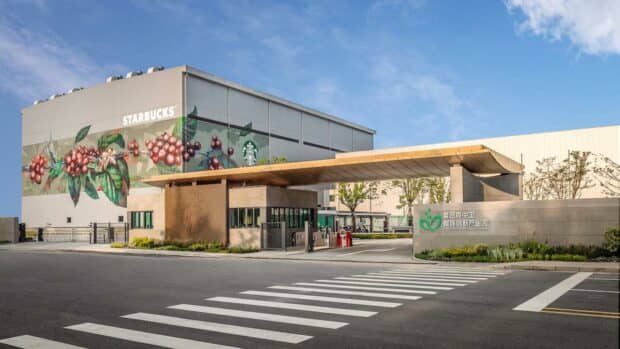Seattle-based international coffee giant Starbucks has opened a $220 million coffee production and distribution facility in China while signaling ambitious retail expansion plans.
Referred to by Starbucks as the Coffee Innovation Park (CIP), the production plant is located in the city of Kunshan, about an hour outside of Shanghai, while occupying 80,000 square meters (more than 860,000 square feet). The project was announced in 2020 with an initial price tag of $130 million.
In addition to roasting production, warehousing, packaging and distribution areas, the facility also includes a public “Experience Center,” where guests can learn about coffee and Starbucks’ marketing efforts.
“As one of the largest consumer markets in the world, China presents tremendous opportunities for Starbucks. The Coffee Innovation Park highlights Starbucks foresight in elevating the supply chain through digitalization and advancing our sustainability agenda, enhancing our unique competitive advantage as we accelerate our global growth,” Starbucks CEO Laxman Narasimhan said in an announcement of the opening yesterday. “As Starbucks largest and fastest-growing international market, we will continue to deepen our investment and reinforce our unwavering long-term commitment to the China market.”
Representing Starbucks’ largest facilities investment outside the United States, the plant opening further solidifies Starbucks’ presence in the Chinese coffee market, both as a retailer and as a green coffee buyer/roaster.
A Starbucks Coffee location in Shanghai, China. “Starbucks in China” by suttonls is licensed under CC BY 2.0.
The company first opened a store on mainland China in 1999, before opening a “farmer support center” in China’s primary coffee growing region, Yunnan, in 2012. By 2016, former Starbucks CEO Howard Schultz announced intentions to make China Starbucks’ largest retail market, ahead of the U.S.
The company — which is embroiled in labor disputes in its home country — currently has more than 6,500 stores across more than 250 Chinese cities, with plans to operate 9,000 stores in China by 2025 through investments of more than $450 million, according to yesterday’s announcement.
Despite steadily growing coffee consumption in traditionally tea-drinking China, it remains one of the world’s largest untapped consumer markets. According to the most recent estimates from the USDA’s Foreign Agriculture Service, Chinese consumption for the 2022-23 market year was estimated to equal approximately the equivalent of 4.8 million 60-kilo bags of coffee. That would place China between Canada and Indonesia in terms of total consumption. By comparison, the U.S. was expected to consume nearly 27 million bags, while the European Union was expected to consume 42 million.
As for green coffee production, China was expected to produce approximately 1.8 million 60-kilo bags of Arabica coffee in 2022-23. That number would put China just behind Mexico and Nicaragua, and just ahead of Costa Rica and Indonesia, in terms of Arabica production.
“The China coffee culture is clearly in the early chapters of its story,” Narasimhan said in a public announcement to all Starbucks staff members, who are still referred to by the company as “partners,” today. “This is why each element of our CIP is designed to showcase our coffee heritage, unlock efficiencies, reduce waste, and strengthen and scale our technology to further elevate our customer and partner experience and differentiate us in the market.”
Does your coffee business have news to share? Let DCN’s editors know here.


